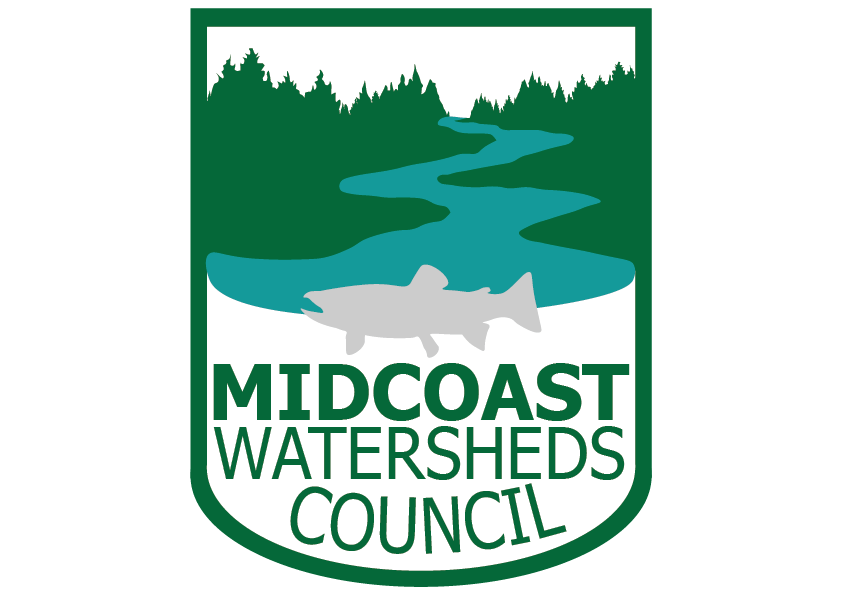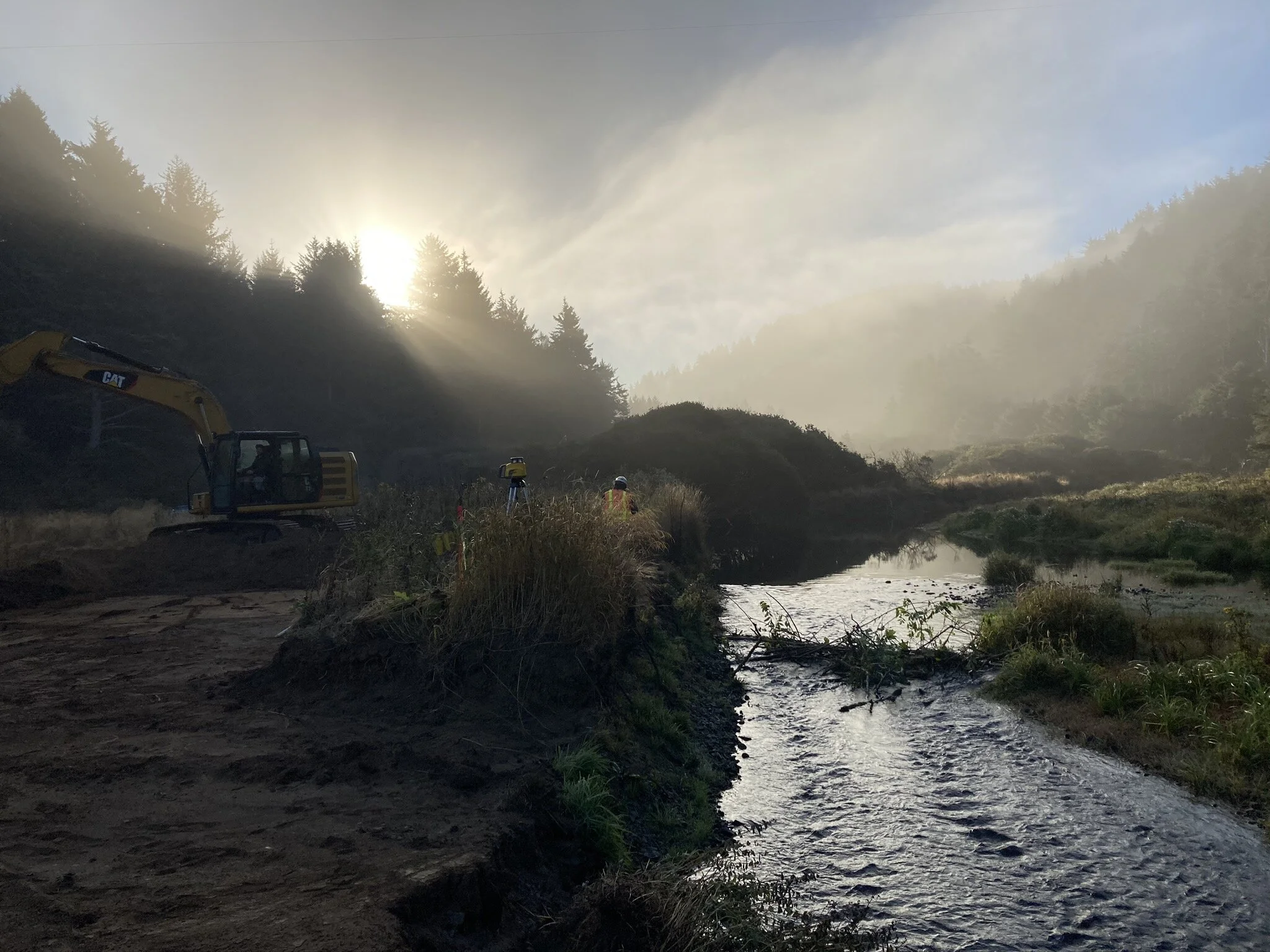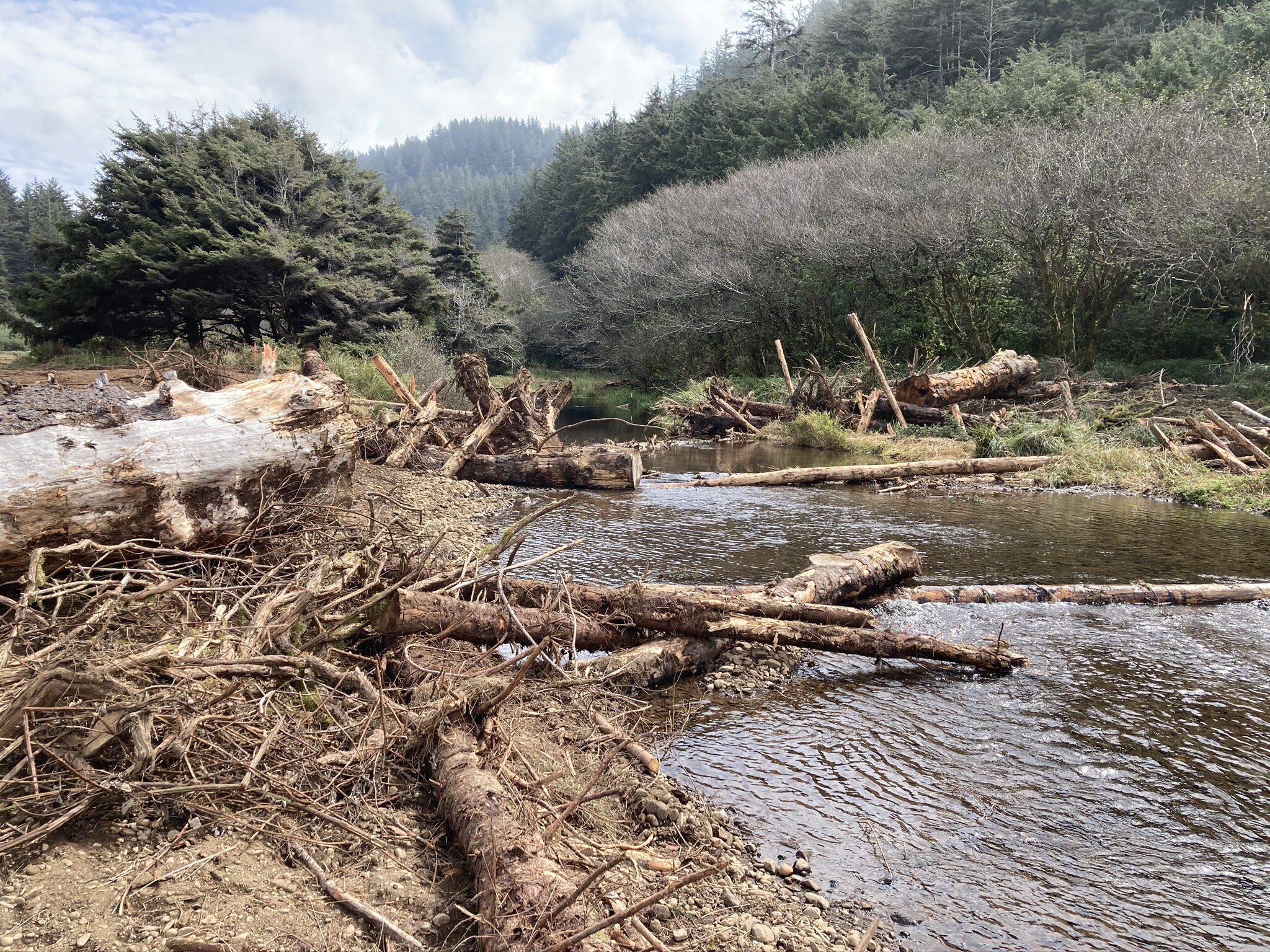An excavator works early in the morning on floodplain at Big Creek. A cultural resources monitor was present on site for all excavation work. To the right, in Big Creek itself, a small beaver dam was built over the previous night.
Just above Highway 101, where Big Creek flows into the ocean about 10 miles south of Yachats, a $425,000 salmon restoration project has just been completed. The project, on land owned by Oregon Parks and Recreation Department (OPRD), will help restore the creek from past degradation to benefit salmon and other wildlife species.
The project was conducted by the MidCoast Watersheds Council (MCWC) and OPRD, with contributions from the U.S. Forest Service (USFS), Oregon Department of Fish and Wildlife, Siuslaw Soil and Water Conservation District, and the Confederated Tribes of the Coos, Lower Umpqua and Siuslaw Indians (CTCLUSI). The majority of the funding came from the Oregon Watershed Enhancement Board, OPRD, and USFS. Additional support came from Oregon Department of Transportation and the Northwest Oregon Restoration Partnership.
The restoration work created 14 acres of floodplain habitat, restored wetlands, established 10 in-stream habitat structures along a half mile of stream, and placed over 200 logs on the floodplain. It is designed to benefit multiple fish species, including threatened coho salmon, as well as Chinook, steelhead trout, cutthroat trout, lamprey species, and eulachon. The project will also benefit numerous other wildlife species such as the endangered Oregon silverspot butterfly and beaver. In fact, several of the habitat structures were designed to act as beaver dam “anchors” to encourage dam building and long term residence. That way these “ecosystem engineers” will continue to create and maintain healthy stream habitat long after the crews and heavy equipment have moved out.
“Our work, while focused on restoring fish and wildlife habitat, also benefits the community directly”, explained project manager and MCWC Coordinator, Evan Hayduk. “Our large wood and floodplain work will help ensure that flood waters have somewhere to go without hurting infrastructure. We also hired local area contactors to keep money flowing in the community. We used Trask Design and Construction, a family owned and operated business from Alsea/Corvallis, for this project. They are great to work with and have a real passion and expertise when it comes to this kind of work.”
Over 5,000 cubic yards of artificial fill was removed from the Big Creek floodplain in three major areas. This will increase floodplain connection and rectify past degradation.
There were also two contractors hired to watch all the excavation work to ensure that no cultural resources were damaged, since this area was historically used by the CTCLUSI. Tribal representatives were also on site before and during construction and described how the area may have been used. “This area was historically very important for Tribal groups. Just to the north of here, Tenmile Creek was an important trading area between tribes” according to Jesse Beers, CTCLUSI Cultural Stewardship Manager. Bryan Gillooly, Restoration Projects Manager for the tribe added that “The Tribe greatly appreciates the opportunity to partner on these aquatic restoration projects. The project at Big Creek demonstrates the hard work and inclusiveness of the Mid-Coast Watershed Council and their partners as they endeavor to restore native fish for the next seven generations.”
A majority of the Big Creek basin is relatively undisturbed and in excellent condition. Most of the watershed is publicly owned forest lands, and a subset is designated as Wilderness Area. This makes this project in the lower reaches of the watershed all the more important as it focuses on areas of degradation in an otherwise healthy watershed. These improvements in the lower watershed will provide slow-water habitat that is otherwise lacking for salmon juveniles during a critical stage in the salmon life cycle.
Ten “large wood” habitat structures were placed Big Creek. Large woody debris plays a vital role in stream systems, increasing stream complexity, providing cover for fish, sorting out spawning gravels, and maintaining floodplain connection at high flows.
This important lowland area was once in danger of being converted into a destination resort. For almost 20 years, beginning in the 1990s, the community rallied against that proposal. Finally, in 2009, The Nature Conservancy acquired the property until public agencies could protect it. That effort, documented in the book Saving Big Creek by Yachats author Andrea Scharf, showed the community support for keeping Big Creek undeveloped and fish friendly. This summer’s restoration project will help realize that goal.
Jeff Feldner, a former commercial fisherman who serves on the MCWC Board of Directors emphasized the importance of this project. “We know that adult and juvenile salmon will benefit from the protected pool habitat that the wood structures create in the stream and from the overhanging native vegetation. Even more important is the habitat we’ve created for the vulnerable young salmon that would otherwise be washed to sea. Now they’ll be able to shelter in the wetlands and on the floodplain when the stream spreads out its force during high water flows. It’s great to be a part of positive work like this.”
After floodplain excavation, large quantities of large and coarse woody debris were installed in the floodplain area. When flood waters spill into these areas, this material will slow the water and create complex, off-channel fish and wildlife habitat.
Continue to check our website for updates as we monitor this project over time.




